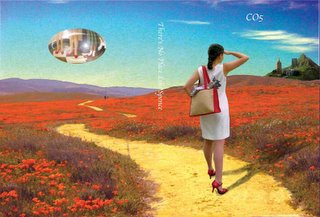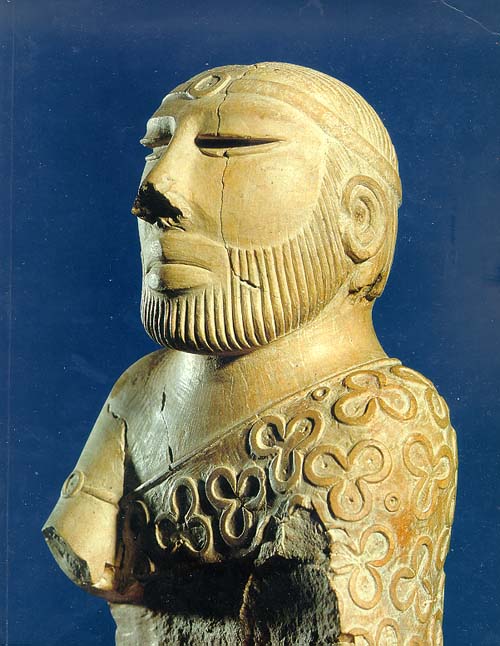While It's Still December...
Good thing I bought T's presents eight months ago, and better yet that they are still in fashion....
Speaking of fashion, here's the picture I made last May for the cover of a DVD I was putting together for my daughter's graduating class. The theme for their Senior Dinner, which was given by the parents, was The Wizard of Oz, and the DVD was planned as a party favor. They're an extraordinarily close and affectionate group, with a great attachment to their beautiful, brill and good-hearted school, and I had proposed the theme, so I was v. happy with the project all around and threw myself into it. Here's what I did for the cover, with about a hundred bucks, a cooperative daughter in her sister's six-year-old school graduation dress, and a few hours in Photoshop.

The picture is a spoof on Dorothy, of course. Here, she's a graduating high school senior with a novitiate eye on style, yet with the looming prospect of college as Oz, where she will no doubt quickly lose her budding dress sense for a while. It had to be a white graduation dress to fit the metaphor, so I stuffed a blue and white checked shirt of mine into the tote to suggest that she had flung off her pinafore with childhood -- because we all know Dorothy wears a blue gingham pinafore -- and stuffed it into the tote right along with Toto, the way people with small dogs do. In the event, because of my difficulties activating Compressor in Final Cut Pro, I had a major crash and didn't finish or duplicate the DVD until late August. It wasn't until early September that about ninety copies went out to a small and close-knit circle with this picture on the DVD case.
Imagine my surprise and mixed emotions when I found my very idea -- the Beginning Fashionista Dorothy, out and about in a nightmare landscape, wearing a plain white dress and high-heeled ruby slippers -- given an industrial strength budget, top speed negotiations with couturiers, hair and makeup stylists, a full cast and and top ranked production talent, and most of all, Annie Leibovitz...and then spread out in variations over twenty pages of the December issue of American Vogue!
Instead of a six-year old linen shift from J. McLaughlin, here were the cleverest new cocktail dresses in white from Vera Wang, Prada, Donna Karan, Nicholas Ghesquière, Lanvin, Marc Jacobs... and a sort of chemise-over-croquembouche number made of white chiffon by Comme des Garçons....a very pale and very twee lavender frock from Rochas, a very pale pink pinafore dress from Oscar de la Renta. Important dresses, every one!
And the shoes! Instead of the sequined ankle strap pumps by a Chinese firm called Cathay Shoes that I had bought on eBay from their distributor in Boston, here were glittery ruby T-strap sandals on five inch heels by Marc Jacobs, glittery red platform loafers from Chanel, glittery cherry mary janes by Miu Miu, red pumps, possibly on six inch heels, by Christian Louboutin, bright red ankle strap sandals from Balenciaga, red velvet pumps from Lanvin and Repetto, red sequined pumps from Rochas, red patent leather from Lanvin....a shoe museum's worth of ruby slippers!
Now, I don't admit that I did such a terrible job improvising with a single barrette, nor that Keira Knightley was an improvement over my daughter, blonde as Dorothy may have been, but I hope KK had a good time and got lots of money. B said it was agony standing that way for more than two seconds, but she did it for me anyway as a one time thing.
I was torn-- on the one hand, nobody had so much as called to thank me, especially galling if I took into account that Stefano Pilati's commissioned sketch had been published and credited in the writeup, and that this spread had served as the perfect counterpart (or riposte?) to the December edition of French Vogue, which was given over to Jean Cocteau's La Belle at La Bête and Kate Moss -- and the song she recorded with Pete Doherty. We're Off to See The Wizard sounds as clean as apple pie in comparison. On the other hand, the spread was a tribute to the girls I did this for in t he first place, and as B pointed out, it was as close as I was ever going to come to getting a compliment from Vogue. The pictures were exactly what I had in my mind's eye, too, though I didn't have the skill, money and experience to pull it off myself, Even Time magazine had given the spread a story of its own, so I could play nice, read it all as wish fulfillment of a sort, and feel perfectly free to pat myself on the back for the rest of my life. After all, it is well known that you can't copyright an idea....
Speaking of fashion, here's the picture I made last May for the cover of a DVD I was putting together for my daughter's graduating class. The theme for their Senior Dinner, which was given by the parents, was The Wizard of Oz, and the DVD was planned as a party favor. They're an extraordinarily close and affectionate group, with a great attachment to their beautiful, brill and good-hearted school, and I had proposed the theme, so I was v. happy with the project all around and threw myself into it. Here's what I did for the cover, with about a hundred bucks, a cooperative daughter in her sister's six-year-old school graduation dress, and a few hours in Photoshop.

The picture is a spoof on Dorothy, of course. Here, she's a graduating high school senior with a novitiate eye on style, yet with the looming prospect of college as Oz, where she will no doubt quickly lose her budding dress sense for a while. It had to be a white graduation dress to fit the metaphor, so I stuffed a blue and white checked shirt of mine into the tote to suggest that she had flung off her pinafore with childhood -- because we all know Dorothy wears a blue gingham pinafore -- and stuffed it into the tote right along with Toto, the way people with small dogs do. In the event, because of my difficulties activating Compressor in Final Cut Pro, I had a major crash and didn't finish or duplicate the DVD until late August. It wasn't until early September that about ninety copies went out to a small and close-knit circle with this picture on the DVD case.
Imagine my surprise and mixed emotions when I found my very idea -- the Beginning Fashionista Dorothy, out and about in a nightmare landscape, wearing a plain white dress and high-heeled ruby slippers -- given an industrial strength budget, top speed negotiations with couturiers, hair and makeup stylists, a full cast and and top ranked production talent, and most of all, Annie Leibovitz...and then spread out in variations over twenty pages of the December issue of American Vogue!
Instead of a six-year old linen shift from J. McLaughlin, here were the cleverest new cocktail dresses in white from Vera Wang, Prada, Donna Karan, Nicholas Ghesquière, Lanvin, Marc Jacobs... and a sort of chemise-over-croquembouche number made of white chiffon by Comme des Garçons....a very pale and very twee lavender frock from Rochas, a very pale pink pinafore dress from Oscar de la Renta. Important dresses, every one!
And the shoes! Instead of the sequined ankle strap pumps by a Chinese firm called Cathay Shoes that I had bought on eBay from their distributor in Boston, here were glittery ruby T-strap sandals on five inch heels by Marc Jacobs, glittery red platform loafers from Chanel, glittery cherry mary janes by Miu Miu, red pumps, possibly on six inch heels, by Christian Louboutin, bright red ankle strap sandals from Balenciaga, red velvet pumps from Lanvin and Repetto, red sequined pumps from Rochas, red patent leather from Lanvin....a shoe museum's worth of ruby slippers!
Now, I don't admit that I did such a terrible job improvising with a single barrette, nor that Keira Knightley was an improvement over my daughter, blonde as Dorothy may have been, but I hope KK had a good time and got lots of money. B said it was agony standing that way for more than two seconds, but she did it for me anyway as a one time thing.
I was torn-- on the one hand, nobody had so much as called to thank me, especially galling if I took into account that Stefano Pilati's commissioned sketch had been published and credited in the writeup, and that this spread had served as the perfect counterpart (or riposte?) to the December edition of French Vogue, which was given over to Jean Cocteau's La Belle at La Bête and Kate Moss -- and the song she recorded with Pete Doherty. We're Off to See The Wizard sounds as clean as apple pie in comparison. On the other hand, the spread was a tribute to the girls I did this for in t he first place, and as B pointed out, it was as close as I was ever going to come to getting a compliment from Vogue. The pictures were exactly what I had in my mind's eye, too, though I didn't have the skill, money and experience to pull it off myself, Even Time magazine had given the spread a story of its own, so I could play nice, read it all as wish fulfillment of a sort, and feel perfectly free to pat myself on the back for the rest of my life. After all, it is well known that you can't copyright an idea....




